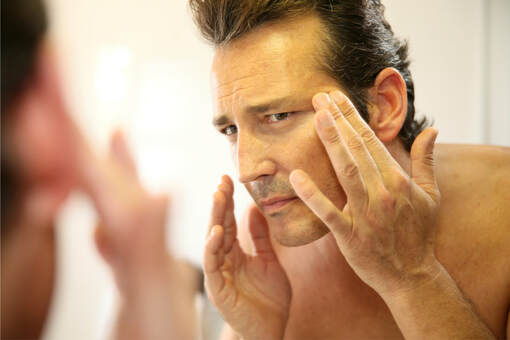|
We are not human beings having a spiritual experience. We are spiritual beings having a human experience. ~ Pierre Teilhard de Chardin The concept of anti-aging may encompass many areas, approaches, and lifestyle attributes. I suppose due to the marketing influences, when we think and speak about anti-aging, typically anti-aging supplements and products are the first things that come to mind. And, frankly, that area is where my anti-aging interests first originated some 15 years ago. As my body of knowledge and experience in the field expanded, so did my philosophy and methods. It is evident to me now that the anti-aging supplements, as effective as some of them truly are, are the tip of the iceberg. The pyramid below depicts the framework I now use to approach the anti-aging lifestyle and priorities. Certainly, I do not view the spiritual component as for anti-aging only, it is a part of the overall path and growth. Nevertheless, no anti-aging journey is complete without it. MIND and body
Science is a common denominator for everyone regardless of what they believe in. So, let's start by pointing at psychosomatic reactions. Emotional trauma, prolonged stress, anxiety, and anger, unresolved inner conflicts, unresolved negative emotions, including those shoveled to the cellars of the subconscious mind, eventually manifest in the physical body, first as a dysfunction, and later as a diagnosable disease. Just some scientific data that speaks of that -
What approaches do I place in this layer?
There is no one-size-fits-all with the mind and spirit, but everyone can find something that works for them. If you are feeling a little adventurous and care to venture into psychology and metaphysical world, works of Carl Jung, Edgar Cayce, Vadim Zeland, to name just a few, and even New Testament all contain references to the importance of spiritual and psychological health for the lifespan and health of the physical body. If you adhere to materialistic views, then just disregard this paragraph. healthy lifestyle
This is a much more straightforward part. While there are different healthy diet preferences, and different sports, exercise and physical activities, everyone will agree on the importance of keeping one's body in a good shape.
anti-aging extras
These are the ones that people typically think of when talking about anti-aging. Yet, they are not going to be very effective if the first two layers are amiss.
The break-down of the activities and approaches given above is not necessarily clear cut. My objective was to convey the model I apply and to highlight the importance of looking at a bigger picture, beyond just the anti-aging supplements and biohacking, rather than to provide a precise classification. For example, taking an Omega-3 supplement may count as both a healthy lifestyle and an anti-aging extra effort. Doing yoga may be a part of the physical activity and a healthy lifestyle, but may also contribute to the peace of mind and spiritual health. Fasting spans across all three layers. As a side note, the field of medical aesthetics with its multitude of face, skin and body rejuvenation treatments, for the most part, can be and is also referred to as anti-aging. I consider that area "rejuvenation treatments" and did not include it into the anti-aging framework. Still, rejuvenation treatments make many people happy (and that is what counts), and there is a lot of face, skin, body aging and anti-aging information at Medical Aesthetics Information Platform and Solutions. If you have no preference where to start with your anti-aging efforts, I would suggest starting at the layer of the spiritual and psychological health, whatever your preferred tools are.
If the "mind and spirit first" approach is not for you at this point in life, like it was not for me 15 years ago, start (or continue) whatever aspect you feel like the most right now, because that is your inner guide as to what the best place for you to start with is. Namaste.
3 Comments
"Do you know any proven ways to slow down and reverse hair loss?" "I am working out and eating healthy. Yet I am seeing signs of aging on my face. Why? And what can I do about it?" I have been receiving many private messages from men with questions similar to those ones and decided to write a separate post on the matter. In this post: male facial aging concerns - anti-aging in general and facial aging; male facial aging - three lines; rejuvenation options; information resources; male medical aesthetics is a growing trend; basic anti-aging advice. Facial aging and anti-agingI will begin by saying that unfortunately this is not entirely an anti-aging question. Yes, nutrition, physical exercise, sleep, alcohol consumption, smoking, anti-aging supplements, fasting, etc influence how young a face looks; however, a person can be perfectly healthy and fit and have an amazing body, and the face will still show signs of aging due to genetics, environmental factors, prior weight gain - weight loss cycles, or, what I call, tear-and-wear. There are several anatomical layers on the face: several layers of skin (epidermis and dermis), superficial fat pockets, muscles, deep fat pockets, connective tissue and, possibly, interstitium, and the bones. While the lifestyle and anti-aging regimens have a large impact, the anatomical layers still age, and they age at a different pace, under the influence of different factors. Facial and body rejuvenation above and beyond what is/can be achieved with the lifestyle changes and anti-aging supplements is addressed by the medical branch called medical aesthetics. Male facial aging concerns - the three linesMDs who specialize in the male facial aesthetic treatments and know what their clients want, use an almost coined phrase, "Men are concerned with three lines: jawline, eyeline, and hairline." (unlike women who are concerned with so much more :)) Jawline - lost definition of the lower face, facial sagging and/or fat accumulation under the chin/jaw. Eyeline - dark circles, hollowness or puffiness, "I look tired". Hairline - the hair loss that frequently starts in 20s and affects at least 50% of men. I will also add the fourth one - a deep line(s) between the eyebrows. Rejuvenation optionsIt is always better to prevent an issue than to correct it, and at the end of the blog post I included some basic anti-aging advice. For those who are already facing the issues, modern aesthetic medicine and cosmetic industry offer numerous options, including inexpensive and non-invasive ones, for the facial rejuvenation and hairline restoration. The full high-level lists of options to treat the three lines are - Hairline:
Unfortunately, even in a long blog post, it is not possible to give an answer suitable for everyone as to what the best option is, not only because of the number of the options, but also because reasons for an aged look and the stage of aging vary from person to person, and the most suitable option also depends on the age of a patient and the budget. Take the hair loss, for example. It may be tempting to give an advice like in many blogs, "use minoxidil 5%, it's inexpensive, and has a high likelihood of effectiveness". The reality is that -
Every situation is different, and in the section below I included information sources for research on possible treatments. In the end I also included a generic preventative facial anti-aging advice. If you don’t have time for research and want information and advice geared precisely to your situation/question, I give private paid consultations on the phone (I have all the information starting with the facial anatomy, anatomy of the facial aging, and the treatment options, but I do not perform any treatments). The line between the eyebrowsAn easy answer can be given only to the question on treating the line (deep wrinkle) between the eye brows. The only truly effective way to deal with it is an injection of Botulinum Toxin (Botox, Xeomin, or Dysport). The Botulinum Toxin injections are statistically number one non-invasive cosmetic procedure, with 7.2 million procedures performed in 2017 in USA alone (2018 data is not yet available). Roughly 11% of those 7.2 mln procedures were performed for male patients. The major difference between Botox injections between genders is that on the face too, men have bigger and stronger muscles and men typically require an injection of more units of Botox than women do to achieve the same result. The effect from the injections lasts 4 to 6 months, after that the muscle returns to the same state it was before the injection. Information Sources for ResearchThere is a lot of information on the facial aging and rejuvenation treatments at:
Medical aesthetics for men is a growing trendIn case you were curious... There already are medical aesthetics clinics, and more are opening, specializing in male procedures. In South America this was the case already 15-20 years ago; USA and Canada are starting to catch up. This is in addition to the medical aesthetics clinics, centers, spas, plastic surgery centers that service clients of both genders. To clarify, aesthetic and cosmetic procedures include a wide range of non-surgical, non-invasive or minimally invasive options such as injectables and various device enabled treatments. To elaborate on why there are separate clinics for men -
The point is that the mere fact that the number of those clinics grows is an indicator of the flourishing demand for the male aesthetic procedures, including facial ones. The statistics by American societies of plastic surgeons confirm the trend. Reasons why men get interested in aesthetic treatments vary -
Whatever the reason, worldwide, male rejuvenation/aesthetic/cosmetic procedures is a fast growing area of the medical aesthetics. A recent survey showed that 40% of men were interested or possibly interested in cosmetic procedures, 43% were not satisfied with facial appearance. And sales in men's grooming industry reached $50 billion in 2017. It is worth noting that men are more reluctant than women to reveal even to their peers that they had any cosmetic procedure done and they are less tolerant to the downtime after procedures. Basic preventative anti-aging advice for the faceJust like with any anti-aging, the best strategy is to prevent rather than to correct. What measures above and beyond healthy lifestyle and broad-spectrum anti-aging approaches can be taken to delay the signs of facial aging?
Any comments, questions or suggestions are welcome. What is BLSA?The Baltimore Longitudinal Study of Aging (BLSA) started in 1958 and is conducted by the Intramural Research Program of the National Institute on Aging (NIA), part of the National Institutes of Health at the U.S. Department of Health and Human Services. It is the longest-running study of aging and longevity in the world, has involved over 3,000 participants and resulted in hundreds of scientific publications. Majority of the studies on aging are cross-sectional: they compare participants in one age group to participants in another age group. The supremacy of BLSA is that it observes over decades changes in health of the participants thus reducing the distortion from external factors. The BLSA is considered a gold-standard for longitudinal and aging research. Objectives of the studyThe core focus of the study is finding and defining what 'normal aging' is. There is a difference between disease later in life that results from improper lifestyle, nutrition etc and 'normal' aging - healthy tear-and-wear. Another major goal is to identify the relationship between aging and disease. As the National Institute of Aging put it, the idea is to establish "the true effects of aging and how to separate factors such as disease, socioeconomic disadvantage, [...] from the underlying biological or other mechanisms common to human aging". People age differently, yet scientists were able to establish age-related changes that will be experienced by almost everyone. The value of the BLSA findings for those who are interested in increasing their own life span and health span is, among other things. in pinpointing the areas that may benefit from early intervention above and beyond simply healthy lifestyle. It is always easier to prevent than to correct. Some of the Main and Most Interesting Findings
Basic recommendations for healthy agingNever hurts to remind ourselves -
Sources and ReferencesFabbri E, An Y, Zoli M, et al. Association Between Accelerated Multimorbidity and Age-Related Cognitive Decline in Older Baltimore Longitudinal Study of Aging Participants without Dementia. J Am Geriatr Soc. 2016;64(5):965-72. https://www.ncbi.nlm.nih.gov/pmc/articles/PMC4882249/ Ferrucci L. The Baltimore Longitudinal Study of Aging (BLSA): a 50-year-long journey and plans for the future. J Gerontol A Biol Sci Med Sci. 2008;63(12):1416-9. https://www.ncbi.nlm.nih.gov/pmc/articles/PMC5004590/ Gittings N. S., Fozard J. L. Age related changes in visual acuity. Experimental Gerontology. 1986;21(4-5):423–433. doi: 10.1016/0531-5565(86)90047-1. https://www.ncbi.nlm.nih.gov/pubmed/3493168 Moore AZ, Caturegli G, Metter EJ, et al. Difference in muscle quality over the adult life span and biological correlates in the Baltimore Longitudinal Study of Aging. J Am Geriatr Soc. 2014;62(2):230-6. https://www.ncbi.nlm.nih.gov/pmc/articles/PMC3945403/ Acessed on February 7 -9, 2019 - https://www.nia.nih.gov/research/blog/2014/04/valuable-data-resource-baltimore-longitudinal-study-aging https://www.nia.nih.gov/health/what-do-we-know-about-healthy-aging https://www.nia.nih.gov/research/labs/blsa/advances-aging-research https://files.eric.ed.gov/fulltext/ED292030.pdf http://medfac.tbzmed.ac.ir/uploads/User/5247/healthy_aging_lessons_from_the_baltimore_longitudinal_study_.pdf Categories All For those unfamiliar with the topic, accumulation of senescent (old, damaged, no longer replicating) cells in our tissues and organs is one of the reasons why our organs lose their functionality and why we age. Not only those old cells malfunction, they also secret pro-inflammatory signals (Jian-Lin Res, 2009) and produce toxic substances into the extra-cellular environment, thus leading to many age-related diseases. Moreover, they translate the senescent phenotype to the neighboring cells suggesting to them to assume the same senescent expression. When we are young, our immune system promptly eliminates the senescent cells. As we grow older, this house-cleaning process slows down. Elimination of the senescent cells, along (ideally) with periodic activation of telomerase (telomere lengthening enzyme/process), is one of very promising anti-aging strategies. I will cover that approach in detail in one of later posts. A senolytic is a compound or a drug or a supplement that selectively kills senescent cells leaving healthy young cells unaffected. Fisetin is a flavonoid, a polyphenol found in small concentrations in fruits and vegetables such as strawberry, apple, persimmon, grape, onion, and cucumber. See the fisetin content in food at the end of the post. Fisetin is close in structure to quercetin, but not as well studied. Besides its senolytic properties, Fisetin has also been long known to be an anti-oxidant and to have anti-inflammatory and anti-cancer properties (Maher P, 2015). In addition, Fisetin is not only neuroprotective like other flavonoids, which stems from their anti-oxidant properties, but it is also neurotrophic (causes growth of new brain cells) (Sagara, 2004). Studies on mice and human tissues have also identified that fisetin acts as a senolytic. A recent study (Yousefzadeh M, 2018) looked at 11 promising senolytic compounds, including curcumin and quercitin, and found fisetin to be the most effective. The main findings and conclusions from the study were:
Dosage. What we know -
Toxicity. How much is safe?
Other relevant studies and information:
What we have no information about
Summary
Here is some data on Fisetin in fruit
Fruit/Vegetable Amount µg/g Strawberry 160 Apple 26.9 Persimmon. 10.6 Lotus Root 5.8 Onion 4.8 Grape 3.9 Kiwi. 2.0 Peach 0.6 Cucumber 0.1 Feel free to comment, especially if you have additional information! |



